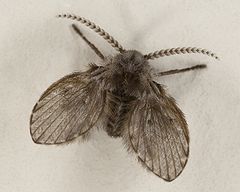The 30 participants in the Zurqui all Diptera biodiversity inventory in Costa Rica have been pushing back our veil of ignorance about the fly fauna of tropical cloud forests. So far, we have spent two full days at the site (Zurqui de Moravia, 20 minutes north of San Jose), and one full day at our partner institution INBio. New species and even new genera of flies are being found everywhere we look. Some examples:
Collaborators Dr. Greg Curler and Sergio Ibanez have found a strange new type of psychodid (moth fly) that holds its wings unlike any other they have ever seen. Most moth flies hold their wings either flat over the body, or roof like over the body; this one inverts its wings over the body so that they make a trough. Significance? Who knows, but it is amazing that such a fundamentally different body form has been found. Last night, Curler hoisted some light traps up into the canopy of the forest to see what other strange things he could discover. Stay tuned for what he found.
Collaborator Dr. Wayne Mathis has been collecting for several days and has pushed our family list to 69 with this collection of diastatids (sorry, no common name), therevids, and anthomyzids, as well as boosting the list of shore flies (Ephydridae) to 26 species.
Netting bats at night has been particularly productive for inventorying bat flies. Dr. Carl Dick has added several genera and species to our list that would never have been included if we had only relied on Malaise traps and other standard insect collecting methods.
In a small raid of army ants, Anna Holden I collected some bizarre short winged phorid flies running around with the ants. These flies, genus Acontistoptera, have fully winged males that transport them in-flight among army ant colonies. We know this because the flightless females turn up in our Malaise trap samples along with their more mobile mates.
Yesterday, we spent the day in the lab at our partner institution INBio, where our collaborators could interact with our Costa Rican staff and examine some of the ZADBI material in the collection. Collaborator Dr. Jeff Skevington looked at our 34 specimens of pipunculids (big headed flies) and pronounced almost every one of them a different species! Little duplication means that there are many more new things still to find.
This is just a taste of what has transpired over the last three days; I’ll get more reports from our scientists today. Lots of ideas have been exchanged, plans made for the future, and scientific papers outlined for publication. Two days still to go!
















